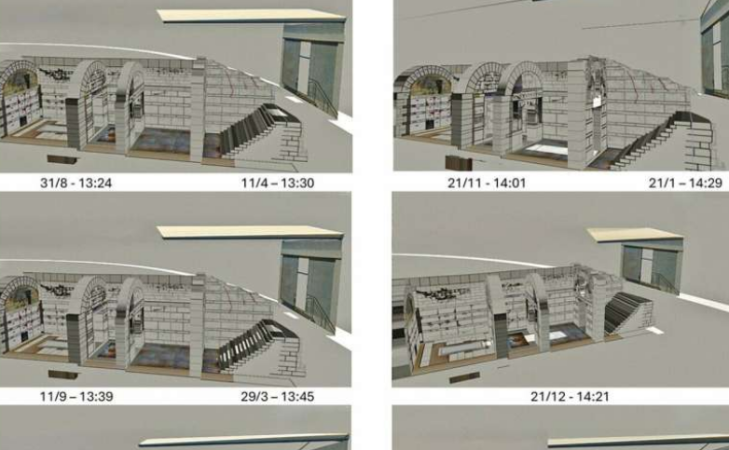Demetrius Savvides, an independent scholar based in Athens, has demonstrated that in Amphipolis, a site located in northern Greece where the tiered, sculpted marble structure known as the Kastas Monument stands, sunlight appears to have been intentionally directed into the core of the tomb in alignment with the winter solstice.
There was once an era when human civilizations placed immense importance on the observation of the heavens. The movements of celestial bodies and the shifting patterns of light across the changing seasons held deep symbolic and spiritual significance. Architects of the ancient world often aligned their stone constructions in accordance with celestial rhythms.
Sanctuaries that are thousands of years old—such as those found at Nemrud Dağ, the Nabataean city of Petra, the temple islands dedicated to Apollo, and the Pantheon in Rome—continue to testify to the work of ancient designers who tracked the sun’s path with extraordinary accuracy. Their efforts have gone on to inspire modern cultural astronomers.
Earlier studies have suggested that architectural designs were deliberately aligned with solar events to amplify ritualistic symbolism or divine associations. To study these possibilities, researchers employ techniques including Geographic Information Systems (GIS), photogrammetry, and 3D digital reconstructions in order to trace the path of sunlight through sacred architectural spaces. While previous investigations have yielded compelling visual representations that appear to reflect intentional planning by ancient builders, these studies often lacked the rigorous quantitative methodology needed to conclusively determine whether such alignments were purposefully engineered.
In 2014, archaeologists uncovered the Macedonian Kastas Monument at Amphipolis in northern Greece. Constructed around 300 BCE, this monument features a marble-paved passageway, or dromos, which leads to four vaulted chambers. Each chamber is marked by distinctive symbolic guardians: headless sphinxes stationed at the entrance, mid-way Caryatids—marble pillars carved into the forms of women—and at the center of the tomb, a mosaic depicting the abduction of Persephone into the underworld.
Solar symbolism was prevalent during the Macedonian era. The Vergina Sun, emblematic of the sun god Helios, appeared on royal coinage. According to Herodotus, myths tied the Argead dynasty to a solar ancestor. Although little has been published about the impact of solar worship on the orientation of sacred Macedonian architecture, the Kastas Monument presents a rare opportunity to examine whether such solar theology influenced the placement of architectural elements such as walls, beams, and burial spaces.
In his study titled "Illuminating the Kastas Monument Enigma: A Computational Analysis of Solar‑Architectural Interaction", published in the Nexus Network Journal, Savvides devised a methodology to quantitatively assess solar alignments within the Kastas Monument throughout the calendar year.
Using field sketches and satellite geolocation data, he established that the marble-lined tomb at Amphipolis, located in northern Greece, is oriented at approximately 208° 38′. It contains four vaulted chambers situated beneath a 30-meter-high earthen mound that was revealed during the 2014 excavation.
Savvides created a highly detailed 3D model of the structure using SketchUp, which he then transferred into Blender and the astronomical simulation program Stellarium. To analyze solar positions specific to 300 BCE, he combined this with custom Python code capable of calculating the sun’s altitude and azimuth.
The simulations showed that on December 21st, the day of the winter solstice, a shaft of sunlight lasting 70 minutes enters the structure, traveling from the doorway flanked by the sphinxes and illuminating the burial cist. Simultaneously, a beam of light passing by the Caryatids casts a matching shadow across the same stone lid. This path of sunlight follows the central symmetry axis of the monument, creating a precise alignment between two significant architectural features—just beneath the top of the arch and the upper portion of the burial cist.
Similar but shorter episodes of sunlight penetration occur in the final weeks of August, October, January, and during mid-February. These instances trace a radiant journey across the tomb’s intricate mosaics and sculpted passageways.
Sensitivity testing revealed that even minor changes in solar position or in the placement of structural components could lead to noticeable shifts in the alignment. A deviation of just ±1° in azimuth caused the corresponding shadow to move by approximately 23 centimeters, while a ±1° alteration in solar elevation shifted the light path by a full meter.
Furthermore, positional displacements of merely 10 centimeters in the sun’s origin point caused the timing of the alignment to shift by an entire day. A vertical displacement of 80 centimeters in the light's entry aperture would shift the solstice-aligned illumination point by three meters and alter the timing by forty days, indicating that the ancient builders likely calibrated their masonry with great precision to match specific astronomical moments.
One particularly significant discovery was the absence of any apparent solar-reactive feature in the third chamber, where the Persephone mosaic remains partially destroyed. Drawing on symmetrical layout and proportional reasoning, Savvides hypothesized the existence of a now-lost architectural element—possibly a statue—that would have completed the tomb’s sequence of solar interactions. A digital reconstruction placed this hypothetical feature atop a pedestal precisely aligned with the light’s incoming path.
Savvides ultimately concludes that during the Kastas Monument’s second phase of construction, an older tomb was transformed into a carefully orchestrated venue for seasonal sunlight, interweaving the mythological narrative of Persephone and Cybele with the political and religious imagery of royal authority.
Since the study of ancient ruins often necessitates computational workflows, the methodology developed by Savvides offers archaeologists a novel and effective approach for testing hypotheses about celestial-architectural relationships at archaeological sites across the globe.

